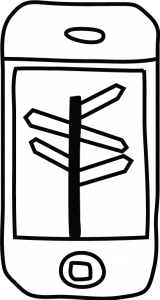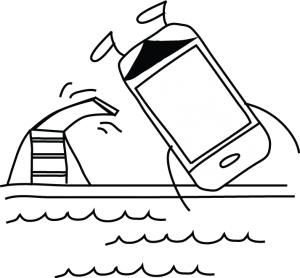 (We have created an 8-part comprehensive report containing a series of two-to-three page “briefs.” This is part 8: Diving into mLearning: How to get started. If you would like to see the collection in its entirety, click here.)
(We have created an 8-part comprehensive report containing a series of two-to-three page “briefs.” This is part 8: Diving into mLearning: How to get started. If you would like to see the collection in its entirety, click here.)
Think small and not huge when you do your first project. At mLearn, we heard stories from companies such as PwC, Abbott Pharmaceuticals, the Federal Bank of Chicago, and several others. Here are tips we gleaned from others’ first efforts:
 1. Think through device choices carefully – lots of people did pilots with Blackberries because those were company-approved devices. By the time pilot ended, IT departments were opening things up to include iPhones and Androids with the assumption/realization that people would use personal devices for work tasks.
1. Think through device choices carefully – lots of people did pilots with Blackberries because those were company-approved devices. By the time pilot ended, IT departments were opening things up to include iPhones and Androids with the assumption/realization that people would use personal devices for work tasks.- 2. Create a policy. You cannot require people to access learning from a mobile device; you can only make it available. You’re going to find that lots of your employees welcome mLearning – but you cannot tell people they have to take learning “on their own time.” (Though companies clearly perceive they are going to leverage time that used to be “downtime.”)
- 3. Decide what a good return on investment is for you. Will you save money over traditional eLearning delivery? Will you save people time? (Note: It does not appear that mobile = money savings, though simple apps can end up saving $$ if you provide people an easy way to access information in the field.)
- 4. Name and involve stakeholders from the beginning. For senior-level executives figure out how to SHOW rather than how to DESCRIBE mobile learning and what you want to do.
- 5. Pilot mLearning on a small scale before launching on a large scale. Be clear on what you want to measure in a pilot. What are you evaluating? What do you hope to “prove?” Here’s a few different examples of what “small” might mean:
What does small mean???
- • Small might mean a very simple solution to a narrow problem (e.g., nurses are having difficulty remembering access steps to an LMS.) Nurse managers have a variety of nurses who work virtually – and frequently call at odd times requesting the access steps to the company LMS. By providing nurse managers with a simple web app that outlines the four steps to walk someone through, it means nurse managers don’t have to log into their computers to walk someone through the steps. Total cost of this solution: $2000.
- • Small might mean “small-ish” when compared to the larger opportunity. Abbott Pharmaceuticals, which sees huge potential in mLearning for its sales force, created three different kinds of mLearning (a course, a game, and a job aid) and tested them on a single district’s sales reps. They used the feedback from these sales reps to decide which prototypes to continue developing. A note: Abbott purchased iPads for pilot testers.
- • Small is relative to the size of the organization. PwC, which has 140K employees, did a pilot involving about 400 of them in two countries– some in the U.S. and some in the UK. They created a different solution for each pilot group and extrapolated enough information to expand their efforts to affect many more countries and many more employees. However, the mobile courses they are developing still comprise a small subset of all courses that would be available to employees. A note: As the project team encountered IT roadblock after IT roadblock, they determined their quickest path to a demo was to purchase 21 Blackberries and load a prototype onto it so they could SHOW rather than TELL executives their concept for mobile learning.
- • Small might mean rolling out a single robust solution to a small group of people. Federal Bank of Chicago repurposed an existing bank examiner course and had six bank examiners take the mobile version of the course. The project took a couple hundred hours to do (so not small in terms of effort) but they sought feedback from a very small group of tester – and limited their exposure to failure.
Planning and Implementing Questions
Business objectives and instructional goals
- • Why mobile as opposed to some other distribution alternative?
- • What results do you want to achieve?
- • Do you have a way of measuring success? How?
- • Is this intended to support performance or is it intended as an actual formal training tool?
Stakeholders
- • Who cares about this project?
- • Who benefits from this project?
- • Are Legal and IT on board?
- • How will this project benefit each group of stakeholders? How will it make life more difficult for them?
- • How mobile is the target audience?
- • How are people leveraging devices now?
Instructional strategies and implementation
- • Who will produce the content?
- • Does the content currently exist or does it have to be developed?
- • What tools will be leveraged for content creation?
- • What interactions/interactivity need to be used?
- • What time parameters for usage are realistic with the intended audience?
- • Can information be “chunked” into stand-alone components or does it need to be viewed/completed in a specific order?
Devices and technical specs
- • What devices are you supporting now?
- • What devices are the optimal choice for what you want to do? Is there a device you currently have…or one you want to gravitate toward?
- • What other initiatives for mobile learning are going on now, or are in the planning stages?
- • What delivery platform makes the most sense– web application or native application?
- • Is Internet connectivity going to be a factor?
- • Is there a need to translate material into multiple languages? (Native apps may not be a great choice if you need them available in multiple languages.)
- • Where will content reside?
- • What content distribution methods do you plan to use (e.g. web application or native application? QR codes? text messaging? etc.)?
- • Who will provide the distribution service?
- • What network will you use for distribution?
- • What security issues must be considered?
- • Do you need to provide training on securing mobile devices?
- • What, if any, user support needs to be provided?
 Our Bottom-Line advice?
Our Bottom-Line advice?
Just do it – but make sure you’re doing it with a problem for which mobile is an obvious and appropriate solution. Also do it with proper planning. The question list here will get you started – and help you recognize that planning IS required!
You might also be interested in:



